There is no doubt that this year NFTs(Non-fungible tokens) have seen major popularity in the crypto community. From celebrities to respected companies, everyone is talking about launching their own NFTs. But not all NFTs are made equal: while some are worth a fortune, some can be practically worthless. Let’s take a look at some of the most profitable ways individuals and companies are making money during the current NFT gold rush.
If you ‘ve seen the headlines about stars like Emily Ratajkowski and Eminem planning to sell NFTs, or stories about Beeple making millions with a collection of NFTs and have some questions, don’t worry – we have the answers. What are NFTs, How is an NFT different from Cryptocurrency, how does it work, what is used for and how to buy an NFT.
The million dollar question is, are NFT’S worth the money or the hype? Some experts characterize them as a bubble poised to pop, like so many other bubbles we say burst in the past(i.e Dotcom craze, Beanie Babies). There are others who believe that NFTs are here to stay, and they have the potential to change investing forever.
Nevertheless, is anyone considers to enter the hype and invest in NFTs, must obtain the basic knowledge and understand the risks involved, like with any other asset.

What is an NFT?
It is a digital asset that represents real-world objects like art, music, in-game items and videos. It is a unit of data stored on a digital ledger, called a blockchain that certifies a digital item to be unique and therefore not interchangeable. NFTs are bought and sold online, frequently with cryptocurrency, and they are generally encoded with the same underlying software as many cryptos.
One of the main reasons NFTs are gaining notoriety now, although they ‘ve been around since 2014, is because they are becoming an increasingly popular way to buy and sell digital artwork. A staggering $174 million has been spent on NFTs since November 2017. In a nutshell, NFTs work in the same way as a certificate of authenticity. If you buy a renown work of art, an antique, or a celebrity signature at auction, you will receive a certificate of authenticity to prove that what you have on your wall is the real deal. One of a kind.
This stands in stark contrast to most digital creations, which are almost always infinite in supply. Hypothetically, cutting off the supply should raise the value of a given asset, assuming it’s in demand.
Someone could argue that, since anyone can view the individual images or even the entire collage of images for free So why are people willing to spend millions on something they could easily screenshot or download?
Because an NFT allows the buyer to own the original item. Not only that, it contains built-in authentication, which serves as proof of ownership. Collectors value those “digital bragging rights” almost more than the item itself.

How is an NFT different from cryptocurrency?
NFT is an acronym for the ‘Non-fungible token’. It’s generally built using the same kind of programming as cryptocurrency, like Bitcoin or Ethereum, but that’s where the similarity ends.
Physical money and cryptocurrencies are “fungible,” meaning they can be traded or exchanged for one another. They’re also equal in value—one dollar is always worth another dollar; one Bitcoin is always equal to another Bitcoin. Crypto’s fungibility makes it a trusted means of conducting transactions on the blockchain.
NFTs are different. Each has a digital signature that makes it impossible for NFTs to be exchanged for or equal to one another (hence, non-fungible).
How does an NFT work?
NFTs exist on a blockchain. Blockchain is a distributed public ledger that records transactions. If you have previous experience with cryptocurrency, you are probably most familiar with blockchain as the underlying process that makes cryptocurrencies possible.
An NFT is created, or “minted” from digital objects that represent both tangible and intangible items, including:
• Art
• GIFs
• Videos and sports highlights
• Collectibles
• Virtual avatars and video game skins
• Designer sneakers
• Music
Essentially, NFTs are like physical collector’s items, only digital. So instead of getting an actual oil painting to hang on the wall, the buyer gets a digital file instead.
They also get exclusive ownership rights. That’s right: NFTs can have only one owner at a time. NFTs’ unique data makes it easy to verify their ownership and transfer tokens between owners. The owner or creator can also store specific information inside them. For instance, artists can sign their artwork by including their signature in an NFT’s metadata.
What are NFTs used for?
NFTs and blockchain technology in general, offer the opportunity to artists and content creators to monetize their wares. They no longer have to rely on galleries or auction houses to sell or show their art. With the avoidance of middlemen, artists can sell their work directly to the consumer through NFTs, which lets them keep more of the profits. Another function of NFTs, is that artists can program in royalties so they’ll receive a percentage of sales whenever their art is sold to a new owner. This is an attractive feature as artists generally do not receive future proceeds after their art is first sold.
In additions, brands like Charmin and Taco Bell have auctioned off themed NFT art to raise funds for charity. Charmin dubbed its offering “NFTP” (non-fungible toilet paper), and Taco Bell’s NFT art sold out in minutes, with the highest bids coming in at 1.5 wrapped ether (WETH)—equal to $3,723.83 at time of writing.

How to buy NFTs
In order to be able to buy NFTs, you will first need to get a digital wallet that allows you to store and secure NFTs and cryptocurrencies. You’ll likely need to purchase some cryptocurrency, like Ether, depending on what currencies your NFT provider accepts. You can buy crypto using a credit card on crypto platforms. You’ll then be able to move it from the exchange to your wallet of choice. You’ll want to keep fees in mind as you research options. Most exchanges charge at least a percentage of your transaction when you buy crypto.
Conclusion
It seems like the NFT gold rush is only starting as more and more individuals and businesses decide to enter the Non-Fungible Token ecosystem. The fact that the most popular NFTs are still simple images suggests that the market is still very undervalued – the true eruption in NFT popularity might not begin until complex Non-Fungible Tokens exploring the full potential of the new technology become more popular.
It’s important to note that the NFT space is still in its infancy. Therefore, expect to see new platforms edge out the current batch of top NFT projects in 2021. As of now, the term NFT is slowly moving away from visions of gaming and CryptoKitties to the painting, DeFi, ticketing, digital identity and other use cases. In fact, its application scope is only limited to the imagination of the cryptocurrency community and developers.
Tether(USDT) and Bitfinex investigated by SEC: What happened and how it ended
Industries most impacted by the pandemic and when to expect recovery
Industries most impacted by the pandemic and when to expect recovery
Industries most impacted by the pandemic and when to expect recovery
The battle of Wall street and Reddit: An inspiring story and what you need to know
The battle of Wall street and Reddit: An inspiring story and what you need to know. Read about the battle of Wall street and Reddit.





